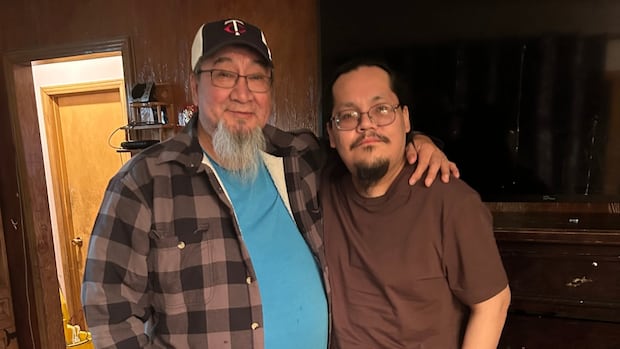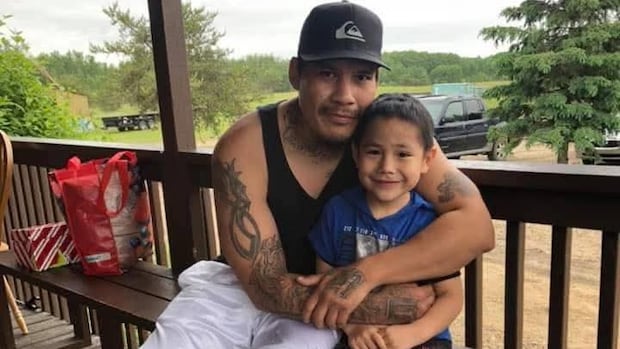A grieving father from a northern Manitoba First Nation says he spent days phoning officials and filing paperwork before he was allowed to take the remains of his son back to his evacuated home community for burial.
But even after fighting to get that approval, Andrew Colomb says he had less than three hours to fly and boat into the community, dig his son’s grave and lay his body to rest, leaving no time for traditions or even a ceremony to say goodbye.
“I had to negotiate real hard … to get my loved one home,” said Colomb, who is from Marcel Colomb First Nation, about 800 kilometres northwest of Winnipeg.
“But there is no planning for this kind of situation until it happens. It is very difficult for people to be supported properly.”
Colomb’s 35-year-old son, Featherstone, died in Brandon, Man., on Aug. 1. His death happened suddenly, Colomb said, less than a month after he and his two children were forced out by wildfires from their home in Marcel Colomb First Nation.
CBC has agreed not to use Featherstone’s last name.
To honour the life of his son, whom he remembers as a quiet and helpful man, Colomb planned to lay Featherstone to rest under traditional practices, including bringing his body back to the community where he grew up.
But the remote First Nation, which has no year-round road access, remains under a mandatory evacuation order, restricting access for all residents, even in Colomb’s case.
“There’s no recognizing the human impact. It’s more procedure and policy,” he said. “That came first.”
With Featherstone’s body held in a morgue in the northern Manitoba town of The Pas, Colomb contacted the RCMP and Manitoba Conservation to request an exemption for a burial in Marcel Colomb First Nation.
The request was bounced back and forth between the two, Colomb says, before he was told by Conservation to call around Aug. 13 — three days before the intended burial — to get confirmation.
“We weren’t sure if they were going to allow us to do it. That was hell for me,” he said.
The family was finally authorized by Conservation to fly Featherstone’s body to Lynn Lake, the nearest town with an airport, on Saturday, Aug. 16.
They were able to get a plane from a neighbouring community to fly in, but since it was being used by Manitoba Hydro crews working to restore power, it was only available for a two-and-a half-hour window — during which Colomb would have to fly in, bury his son and leave the First Nation.

From the Lynn Lake airport, they had to drive with the coffin and then take it by boat to Marcel Colomb. Only six relatives flew to the community — the burial happened without other family and friends, Colomb said.
“We did a little ceremony there, and that was it,” he said.
It was an unceremonious goodbye, a “cowboy burial” with no speeches, no sacred fire, no round dancing or feast to bid farewell — just the grave being dug by essential workers who stayed in Marcel Colomb, and Featherstone’s body lowered to rest, Colomb said.
“There was no hugging. It was like racing against time to accommodate [it],” he said.
“It hurts when things are not done properly. It’s more like a half-patch job, and it just sucks.”
Lack of empathy: CAO
Colomb said he wants his experience to be an opportunity for emergency assistance agencies, including Manitoba’s government, to learn how to better support the families of evacuees who experience a death in the family.
A provincial spokesperson said Manitoba works with local governments and partners like the federal Indigenous Services department to ensure culturally appropriate supports are available in the event of a death or a family needing assistance.
Indigenous Services Canada said it’s providing funding to a number of First Nations for mental wellness support, including providers who can support evacuees who have lost a loved one.
But Colomb thinks his request could have been accommodated sooner, and he would have had more time for the funeral if the province had supplied the plane.
Marcel Colomb First Nation’s chief administration officer, Don McCallum, agrees.
The wildfires that forced the community’s residents out in early July have receded, he said, and without an imminent threat to the family’s safety, Colomb’s request had been authorized by the community’s council before Conservation gave him approval.

McCallum said the consent of the community should have sufficed to allow the burial, instead having to go through Manitoba Conservation.
“It is concerning because they’re basically telling us, ‘You can’t go until we say so,'” he said.
Marcel Colomb is waiting on Manitoba Hydro to restore power before it lifts its evacuation order. But without a fixed timeline for a return, McCallum said Colomb’s request should have been accommodated.
“They put a lot of roadblocks up on him,” he said. “The department was not very empathetic, and they put too many constraints on applying the rules when it was unnecessary.”
‘Fragmented, slow’ system
Pukatawagan Deputy Chief Kelly Linklater told CBC News at least two evacuees have died since that northern Manitoba First Nation was evacuated in late May. He declined to share specifics out of respect for their families.
A spokesperson for Manitoba Keewatinowi Okimakanak said the organization, which represents northern Manitoba First Nations, is aware of the evacuee deaths, and said it is committed to supporting families.
Issues around the deaths of First Nations people during evacuations are not just a problem in Manitoba, said Brad Ison, the director of operations at Hazardscape, an organization that supports First Nations with their emergency management and disaster assistance programs.
In Canada, the systems in place to help families who lose a loved one are often reactive, focused on covering costs after a burial instead of having a protocol set in place to provide dignified care, said Ison.
“The current repatriation process is fragmented, slow and culturally insensitive,” he said.

Delays in moving a body after an evacuated First Nation member dies often stem from multiple layers of approvals and an unco-ordinated system involving different authorities, while the First Nations themselves are generally excluded, he said.
Those barriers could be streamlined, said Ison.
Spaces in the centres where evacuees stay should be identified and made available for wakes, he said. Paperwork needs to be condensed, and communication with the family should be managed by an incident commander with the help of cultural liaison, like a knowledge keeper or an elder.
“You’ve got to be able to scale up that system quickly and rapidly to deal with [repatriation],” he said. “In some communities … you’ve got to treat the body a certain way, and it’s got to get to where it needs to be in a certain timeline,” which has to be respected, he said.
It should also be up to the First Nation to decide whether to allow a family back into a community to bury a loved one, Ison said.
“If somebody assesses that the risk to their culture and their traditions and their loved ones who have passed is higher [than] what the present fire risk is, then they have made a decision,” he said.
Andrew Colomb says he was given about three hours to take his son to Marcel Colomb First Nation in northern Manitoba, dig the grave and bury the 35-year-old man, who died in Brandon early this month.








